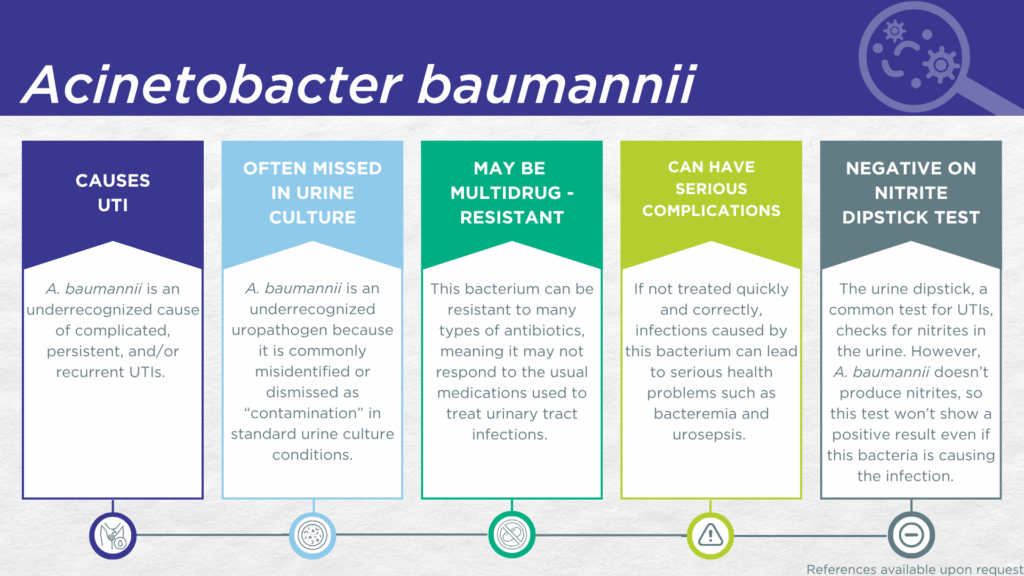A. baumannii

Emery Haley, PhD, Scientific Writing Specialist
Acinetobacter baumannii
Clinical Summary
- A. baumannii is a nitrite-negative, biofilm-forming, gram-negative microorganism.
- Some A. baumannii strains exhibit urinary-tract-specific virulence.
- A. baumannii is reported in complicated and catheter-associated UTIs.
- In symptomatic UTI patients, A. baumannii:
- Is not a contaminant (is found in catheter-collected urine specimens).
- Is viable (can grow out on culture).
- Is pathogenic (associated with elevated urine biomarkers of infection).
- Reported severe complications of A. baumannii UTI include bacteremia, urosepsis, and death.
- Multidrug-resistant A. baumannii (including CRAB) is an “ESKAPE” pathogen and a well-studied significant global health threat.
Bacterial Characteristics
Gram-stain
Gram-negative
Morphology
Bacillus
Growth Requirements
Non-fastidious (grows well in standard urine culture conditions)
Obligate aerobe
Nitrate Reduction
No
Urease
Negative
Biofilm Formation
Yes
Pathogenicity
Colonizer or Pathobiont
Clinical Relevance in UTI
A. baumannii is of one of the six so-called “ESKAPE pathogens” identified as critical multi-drug resistant bacteria requiring urgent development of effective therapeutics.[1] Specifically, carbapenem-resistant A. baumannii (CRAB) bacteremia is an increasingly serious global health threat that can arise secondary to A. baumannii UTI.[2] Approximately 17% of clinical A. baumannii isolates are cultured from urine specimens.[3] In the Study for Monitoring Antimicrobial Resistance Trends (SMART) report, which incorporated 276 A. baumannii strains isolated from UTI patients, over 60% of isolates from North America and up to 90% of global isolates were multi-drug resistant.[4] CRAB bacteremia secondary to UTI is a significant risk in hospital settings,[5] particularly among patients with nephrostomy tubes or indwelling catheters.[3,6] However, community-onset [7] and community-acquired [8] A. baumannii complicated UTIs also occur.
Biofilm formation on medical devices, including urinary catheters, is a common clinical feature of A. baumannii. [9] Furthermore, a plasmid conferring increased urinary tract niche-specific virulence has been identified in A. baumannii strains from catheter-associated UTIs.[10] Intriguingly, in mouse models of UTI, A. baumannii formed intracellular reservoirs in the bladder that could be activated by catheterization months after the resolution of the original infection, suggesting one mechanism for some community-based cases. [11] In a study of community-dwelling older adult males and females with clinically suspected complicated UTI, A. baumannii was detected in both midstream voided and in-and-out-catheter collected specimens indicating that it was truly present in the bladder of such patients, not simply a contaminant picked up during voiding.[12]
It is important to note that, although A. baumannii is non-fastidious and grows well under standard urine culture conditions, the organisms lacks nitrate reductase activity, so diagnostic screening strategies involving urinalysis for nitrite positivity will be false-negative.[13,14]
Together, these findings indicate that A. baumannii should be seriously considered as a uropathogen and demonstrate the value of detecting this organism, particularly in individuals with indwelling catheters or other risk factors for complicated UTI.
Treatment
Evidence of Efficacy (Checkmarks): Ampicillin/Sulbactam, Cefepime, Ceftazidime, Ceftriaxone, Ciprofloxacin, Doxycycline, Gentamicin, Levofloxacin, Meropenem, Piperacillin/Tazobactam, and Sulfamethoxazole/Trimethoprim.
- Miller, W.R.; Arias, C.A. ESKAPE Pathogens: Antimicrobial Resistance, Epidemiology, Clinical Impact and Therapeutics. Nat. Rev. Microbiol. 2024, 22, 598–616, doi:10.1038/s41579-024-01054-w.
- Suh, J.W.; Park, S.M.; Ju, Y.K.; Yang, K.S.; Kim, J.Y.; Kim, S.B.; Sohn, J.W.; Yoon, Y.K. Clinical and Molecular Predictors of Mortality in Patients with Carbapenem-Resistant Acinetobacter Baumannii Bacteremia: A Retrospective Cohort Study. J. Microbiol., Immunol. Infect. 2024, 57, 148–155, doi:10.1016/j.jmii.2023.11.001.
- Bagińska, N.; Cieślik, M.; Górski, A.; Jończyk-Matysiak, E. The Role of Antibiotic Resistant A. Baumannii in the Pathogenesis of Urinary Tract Infection and the Potential of Its Treatment with the Use of Bacteriophage Therapy. Antibiotics 2021, 10, 281, doi:10.3390/antibiotics10030281.
- Lob, S.H.; Hoban, D.J.; Sahm, D.F.; Badal, R.E. Regional Differences and Trends in Antimicrobial Susceptibility of Acinetobacter Baumannii. Int. J. Antimicrob. Agents 2016, 47, 317–323, doi:10.1016/j.ijantimicag.2016.01.015.
- Balfousias, T.; Apostolopoulos, A.; Angelis, S.; Filippou, D.; Maris, S. Pandrug-Resistant Acinetobacter Baumannii Infection Identified in a Non-Intensive Care Unit Patient: A Case Study. Cureus 2019, 11, e6321, doi:10.7759/cureus.6321.
- Hamidian, M.; Nigro, S.J. Emergence, Molecular Mechanisms and Global Spread of Carbapenem-Resistant Acinetobacter Baumannii. Microb. Genom. 2019, 5, e000306, doi:10.1099/mgen.0.000306.
- Kang, S.J.; Kang, C.-I.; Park, S.Y.; Ha, Y.E.; Joo, E.-J.; Chung, D.R.; Peck, K.R.; Lee, N.Y.; Song, J.-H. Epidemiology and Clinical Features of Community-Onset Acinetobacter Baumannii Infections. Infect. Control Hosp. Epidemiology 2012, 33, 1053–1055, doi:10.1086/667739.
- Akram, M.; Shahid, M.; Khan, A.U. Etiology and Antibiotic Resistance Patterns of Community-Acquired Urinary Tract Infections in J N M C Hospital Aligarh, India. Ann. Clin. Microbiol. Antimicrob. 2007, 6, 4, doi:10.1186/1476-0711-6-4.
- Pour, N.K.; Dusane, D.H.; Dhakephalkar, P.K.; Zamin, F.R.; Zinjarde, S.S.; Chopade, B.A. Biofilm Formation by Acinetobacter Baumannii Strains Isolated from Urinary Tract Infection and Urinary Catheters. Fems Immunol Medical Microbiol 2011, 62, 328–338, doi:10.1111/j.1574-695x.2011.00818.x.
- Venanzio, G.D.; Flores-Mireles, A.L.; Calix, J.J.; Haurat, M.F.; Scott, N.E.; Palmer, L.D.; Potter, R.F.; Hibbing, M.E.; Friedman, L.; Wang, B.; et al. Urinary Tract Colonization Is Enhanced by a Plasmid That Regulates Uropathogenic Acinetobacter Baumannii Chromosomal Genes. Nat. Commun. 2019, 10, 2763, doi:10.1038/s41467-019-10706-y.
- Hazen, J.E.; Venanzio, G.D.; Hultgren, S.J.; Feldman, M.F. Catheterization of Mice Triggers Resurgent Urinary Tract Infection Seeded by a Bladder Reservoir of Acinetobacter Baumannii. Sci. Transl. Med. 2023, 15, eabn8134, doi:10.1126/scitranslmed.abn8134.
- Wang, D.; Haley, E.; Luke, N.; Mathur, M.; Festa, R.; Zhao, X.; Anderson, L.A.; Allison, J.L.; Stebbins, K.L.; Diaz, M.J.; et al. Emerging and Fastidious Uropathogens Were Detected by M-PCR with Similar Prevalence and Cell Density in Catheter and Midstream Voided Urine Indicating the Importance of These Microbes in Causing UTIs. Infect. Drug Resist. 2023, Volume 16, 7775–7795, doi:10.2147/idr.s429990.
- BacDive | The Bacterial Diversity Metadatabase Available online: https://bacdive.dsmz.de/ (accessed on 11 February 2025).
- BioCyc Pathway/Genome Database Collection Available online: https://biocyc.org/ (accessed on 11 February 2025).
Dr. Emery Haley is a scientific writing specialist with over ten years of experience in translational cell and molecular biology. As both a former laboratory scientist and an experienced science communicator, Dr. Haley is passionate about making complex research clear, approachable, and relevant. Their work has been published in over 10 papers and focuses on bridging the gap between the lab and real-world patient care to help drive better health outcomes.